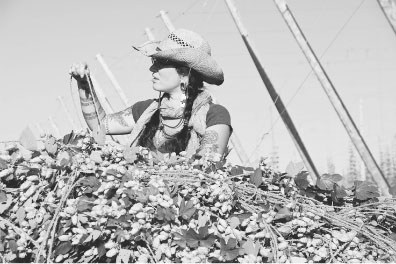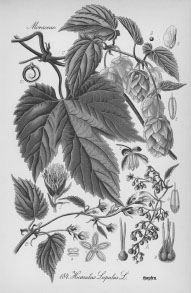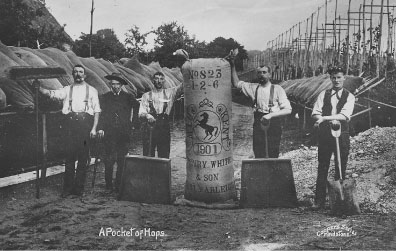Hops are the ingredient in beer that provides its backbone of bitterness, increases its microbiological stability, helps stabilize its foam, and greatly influences its taste and aroma.
For if your ale may endure a fortnight, your Beere through the benefit of the Hoppe, shall continue a moneth, and what grace it yieldeth to the teaste, all men may judge that have sense in their mouths …
Reginald Scot, The Perfite Platform for a Hoppe Garden, 1576.
Hops are the flowers or “cones” of Humulus lupulus, a Latin diminutive meaning roughly “a low [slinking] little wolf [plant],” so-named for the plant’s tactile qualities, prodigious growth, and wide range. The Humulus genus belongs to the family of Cannabinaceae, which includes Cannabis (hemp, marijuana) and Celtis (Hackberry). Hops are native to the Northern Hemisphere in the temperate zones of Europe, western Asia, and North America and are thought to have originated in China. They are now grown commercially in both hemispheres between roughly 30 and 52 degrees latitude. They are hardy plants that can survive cold winters with temperatures as low as –30°C (roughly –20°F). There are five recognized taxonomic varieties in the genus Humulus: lupulus are European hops; cordifolius are Japanese hops; and lupuloides, neomexicanus, and pubescens are North American natives.
“Noble” hops is a historical and commercial term, which is somewhat arbitrarily assigned to four distinct hop landraces, that is, plants that were domesticated in their respective areas and have become open-pollinated, genetically isolated populations there. These are Hallertauer Mittelfrueh from the Hallertau region of Bavaria; Tettnanger from Tettnang in Germany near Lake Constance; Spalt from Bavaria in Germany, south of Nuremburg; and Saaz from the Žatec region of the Czech Republic.
In the trade, hops come in two basic market classes, bittering and aroma hops, with relatively few hops also being marketed as dual-purpose varieties. Bittering, or kettle, hops are added to the wort near the beginning of the boil; and aroma, or finishing, hops, are added any time from 30 minutes before the end of the boil to just at shut-down. They can also be added to the whirlpool, or even later. 
Harvest day on a farm that grows organic hops, Ashland, Oregon.
Ever since the discovery of hops as a suitable beer flavoring, which occurred probably in the 8th century ad, hops have been added to wort as kiln-dried whole cones. Hops need to lose their moisture as quickly as possible after they are harvested, because otherwise they start to rot within just a few hours. Traditionally, hop kilns were housed in oast houses, which by the 19th century had taken on a distinctive circular architecture, with conical roofs that still dot the countryside of many current and former hop-producing regions to this day.
Hops are perennial herbaceous plants that live 10 to 20 years, maintaining a perennial root, called a rhizome, a carbohydrate storage structure that is also found in ginger and the iris plant. Each spring the rhizome sprouts a mass of bines that wrap clockwise around anything they contact. Hops grow vigorously up to 15 m (about 50 ft) tall. In most hop gardens, however, they may reach a height of 4 to 9 m (some 15 to 30 ft). During the peak of the growing season in mid-summer, hops bines may add as much as 50 cm (about 20 inches) per week. The bines are herbaceous, although they tend to form woody, secondary growth on the older tissue late in the season. They die to the ground in winter. Unlike vines, which have tendrils, a bine adheres to its support with its large number of rigid, hooked stem hairs called trichomes. These hold the bine to a substrate. Unfortunately for many hop workers, the oils secreted by trichomes can also irritate the skin.

Botanical illustration of Humulus Iupulus, teh scientific name for the common hop. German, c. 1850. PIKE MICROBREWERY MUSEUM, SEATTLE, WA.
Hops are dioecious (Greek for “two houses”), meaning there are separate male and female plants. Only seedless female hop cones are used in the brewing industry, which is why growers take care to control male plant pollinators in regions where hops are indigenous or cultivated. Male hop plants are less desirable, because they have very small cones that contain only 1/150th of the amount of resin that female cones contain. They also lack some of the essential aroma oils so prized by brewers and beer drinkers. Male plants are tolerated in hop yards only when an open-pollination breeding project is underway. Occasionally a hop plant may turn out to be monoecious, with both male and female flowers on the same plant. But such plants produce only infertile seeds. Modern breeding efforts have produced triploid hop varieties, such as the popular Willamette.
The hop flower, or cone, is botanically a “catkin.” It is an inflorescence that contains a central support called a strig. The strig holds 20 to 60 bracteoles (petals/sepals) along its axis, each with two female floral parts at its base to form a cone-shape flower. The size of the flower varies among hop varieties from an average 2 to 3.5 cm (approximately 0.8 to 1.5 inches) to very large ones of more than 5 cm (2 inches), with shapes varying from round to oblong and somewhat boxy. Lupulin glands, also at the base of the bracteoles, produce the yellow to golden substance called lupulin. It is in the lupulin that the resins—including alpha and beta acids—as well as essential oils are concentrated once the hop cone has ripened.
Alpha acids, also called humulones, which are the sources of most of the bitterness in beer, make up about 3% to 4% of the cone’s weight in aroma varieties. In superalpha bittering varieties—which are the most recent products of many breeding programs around the world—they may make up more than 20%. During the wort boil, alpha acids are converted to water-soluble iso-alpha acids or isohumulones, the true bitter compounds in beer. This conversion, or isomerization, is traditionally one of the main objectives of wort boiling and the boiling time must usually be long enough (at least 45 minutes for most hop varieties) to allow isomerization to take place. That said, isomerization can take place in the absence of boiling, so long as the temperature is high enough; mechanical action, surface area of the hop material, and the contact time are critical factors as well. The unit of measurement for hop bittering potential is the International Bitterness Unit (IBU).
Alpha acids are divided into three analogues—compounds of very similar molecular structures: the desirable humulone and adhumulone and the undesirable cohumulone. Cohumulone may make up anywhere between roughly from 15% to 50% of a hop’s total alpha acid content, depending on variety. It can also vary greatly from one growing year to the next in the same variety. High cohumulone levels in hops tend to result in lower foam stability and a harsher, often unpleasant bitterness. They are also usually associated with poor aroma profiles. Hops are often marketed, in part, based on their cohumulone content.

Postcard, c. 1920, showing workers standing bext to a large sack of hops on a farm in Kent, England. A hop press mechanically packed the hops into these sacks, known as "pockets." PIKE MICROBREWERY MUSEUM, SEATTLE, WA.
As the alpha acids were discovered to actually be three related molecules, the same discovery was made for beta acids, which also come in three analogs: lupulone, colupulone, and adlupulone. The character of a hop, in terms of its bittering and aroma potential, is largely determined by its ratio of alpha to beta acids. The most sought-after aroma varieties tend to have a ratio close to 1:1. Most cultivated hop varieties, however, have a ratio closer to 2:1. Hops with much higher alpha-to-beta ratio are, of course, the modern superalpha varieties. Prior to the 1950s, alpha and beta acids were also called soft resins by virtue of their solubility in hexane, a solvent. Techniques were not developed to separate alpha acids into the three analogues until much later. In early accounts, therefore, all alpha acids were simply referred to as “humulone” and all beta acids as “lupulone.” Lupulone provides potent antimicrobial properties and is active against Gram-negative bacteria such as Staphylococcus and Clostridium.
Essential oils in hops are responsible for the distinct hop aroma. Some fresh hops smell very citrusy, such as Cascade, which has a grapefruit–piney bouquet, whereas others, such as Strisselspalt, have a more floral bouquet. The main essential oils in hops are humulene, which has a woody, balsamic aroma; carophyllene, which has a black-pepper, spicy aroma; myrcene, which has a geranium-like, floral aroma; and farnesene, which has a gardenia-like floral aroma. Of these, farnesene is often either completely absent or represented in only miniscule quantities. Other essential oils, such as linalool with its citrus-like bergamot aroma, although present in only tiny amounts, may have a disproportionately high impact on the overall aroma of certain hop varieties.
Hop researchers have identified roughly 300 compounds that are likely contributors to hop aroma profiles. Some of these are pleasant to humans, imparting floral, fruity, and spicy notes, whereas others contribute off-aromas that, when present in excess, can negatively impact beer aromatics.
Components of Essential Oils in Hop Lupulin
Aroma descriptor | Essential oil/odorant | |
|---|---|---|
Fruity | Citrus, bergamot Citrus, balsamic Citrus Citrus, soapy Pineapple Pineapple Pineapple Apple-like Raspberry Black currant Fruity Fruity | Linalool Limonene Octanal Nonanal Ethyl 2-methylpropanoate (3E,5Z)-Undeca-1,3,5-triene (3E,5Z,9E)-Undeca-1,3,5,9-tetraene (+ /–)-Ethyl 2-methylbutanoate 4-(4-Hydroxyphenyl)-2-butanone 4-Methyl-4-sulfanylpentan-2-one Methyl 2-methylbutanoate Ethyl 2-methylbutanoate |
Floral | Gardenia Geranium leaf Geranium leaf Rose Minty | Farnesene Myrcene (5Z)-Octa-1,5-dien-3-one Geraniol 2-Phenylethyl 3-methylbutanoate |
Spicy | Black pepper Aniseed, sweet Soup seasoning | Carophyllene Anethole 3-Hydroxy-4,5-dimethyl-2(5H)-furanone(sotolone) |
Vegetative | Grassy Muscat-like, green Bell pepper Cucumber Cooked potato | (3Z)-Hex-3-enal (Z)-3-hexen-1-ol 2-Isopropyl-3-methoxypyrazine (2E,6Z)-Nona-2,6-dienal 3-(Methylsulfanyl)-propanal |
Nutty | Almond, roasted | 3-Methyl-2-butene-1-thiol |
Caramelized | Honey Honey Sweet, honey Sweet | Phenylacetaldehyde Phenylacetic acid trans-Cinnamaldehyde 3-Hydroxy-2-methyl-4-pyrone |
Woody | Balsamic Vanilla | α-Humulene Vanillin Vanilla |
Earthy | Mushroom Mushroom, balsamic | Oct-1-en-3-one Germacrene |
Chemical | Cabbage Catty, thiol-like Rancid, cheesy Rancid, sweaty | Dimethyltrisulfane 3-Mercaptohexan-1-ol Butanoic acid (Z)-3-Hexenoic acid |
Microbiological | Cheesy Cheesy Fatty | 3-Methylbutanoic acid Pentanoic acid (2E,4E)-Nona-2,4-dienal |
Source: Various studies conducted at Weihenstephan in Germany and the Kyoto University in Japan.
Until well into the high Middle Ages, before hops had become the beer flavoring of choice just about everywhere, brewers used a large variety of herbs, known as gruit in medieval Europe, as well as strange items such as oxen gall, soot, bark, and mushrooms to spice their beers and sometimes to cover up off-flavors.
As hops won out over gruit in most parts of the Continent, it became more and more difficult to keep it out of English ales. In fact, a 1604 English statute laments that “of late great fraudes and deceits are generally practised and used by foreiners merchants strangers and others in foreine parts beyond the seas, in the false packing of foreine hoppes and [the hops are] sold with leaves, stalkes, powder, sand, strawe, and with loggets of wood, drosse, and other soyle for the increase of the waight thereof, to the inriching of themselves by deceit.” These “great fraudes and deceits” apparently caused England an annual revenue loss amounting to the then-stately sum of 20,000 pounds.
In North America, the early settlers found wild hops, which are native to the New World, but they preferred to brew with cultivated varieties that they had known back home, in the Old World, which they either imported or grew themselves from imported rhizomes.
Hop cultivation takes advantage of the plants’ tendency to wind around any support and to produce a large amount of vegetation in a growing season. Early hop yards in upstate New York, in the 1800s, were circular groups of plants growing up on supports that may have been made of hemp twine toward a central pole. Modern hop yards, by contrast, are laid out in a pole-and-cable grid pattern. The poles are placed in the ground at the grid intersections, with the cable connecting the pole tops in all directions. At the beginning of every growing season, V-shape bine supports are strung from the ground to the upper supports, which allow the hop plants to climb skyward. Judicious pruning to just a few bines per plant and careful training of the shoots around the twine help to maximize yields and keep insects and pathogens in check.
Hops are susceptible to many pests, such as downy mildew (Pseudoperonospora humuli) and powdery mildew (Podosphaera macularis formerly called Sphaerotheca humuli). It is now known that resistance to powdery mildew is genetically determined, which allows breeders to select for the chromosomes with that trait. Aphids and spider mites, too, are a perennial problem in hop yards. These are usually controlled with judicious pesticide applications, good agronomic practices, and biocontrol through predatory insects. Finally, there are viruses, such as hop mosaic virus, that can cause severe crop loss and stunting in some varieties. This virus is spread by aphids and is nearly impossible to eradicate. Australia and New Zealand, because of their physical isolation from other landmasses, have entirely avoided many hop pests and diseases and are therefore havens of organic hop production.
The future of hops in beer seems to be assured, but in a bifurcated trajectory. Whereas the consumption of beer—especially of relatively low-hopped beer with IBU values just above the taste threshold—is rising spectacularly in many markets in Asia, Latin America, and Africa, beer consumption in traditional markets has been—and is expected to continue to be—stagnant or declining. In many of these mature markets, however, however, consumer preferences for aggressively bittered brews—some with IBU values at the solubility threshold of alpha acids in wort—and for beers with elaborate and complex aromas are on the rise. For hop breeder, growers, and traders these two seemingly conflicting trends mean that the market push for ever higher superalpha varieties, as well as the market push for ever more interesting aroma varieties, is likely to continue. The superalpha hops will satisfy the brewing industry’s demand for generic bittering cultivated under the most economical conditions for a growth market in minimally hopped mass-market beers. The diversification of disease-resistant but much lower-yielding aroma varieties, by contrast, will cater to the high-value market for sophisticated specialty beers. As the flavor and aroma of hops continue to bedazzle craft brewers worldwide, we may now be seeing, after more than 1,200 years of brewing with hops, the “hoppiest” beers the world has ever seen.
Hop Growers Convention. Proceedings of the Scientific Commission. 2005. http://www.lfltest.bayern.de/ipz/hopfen/10585/sc05-proceedings-internet.pdf/ (accessed November 1, 2010).
